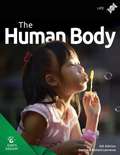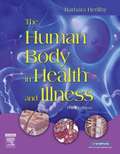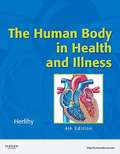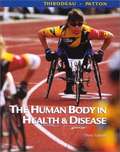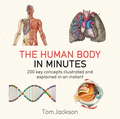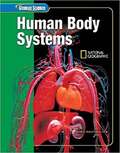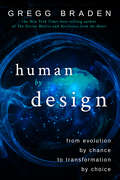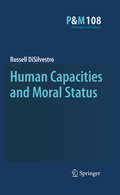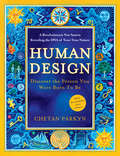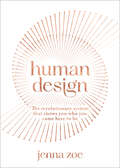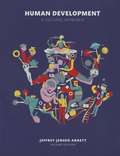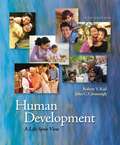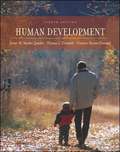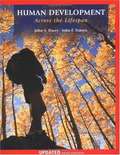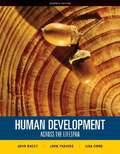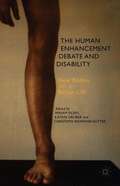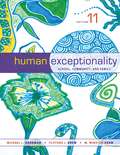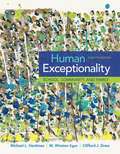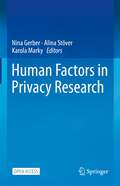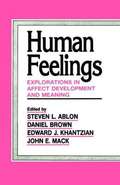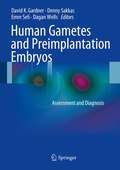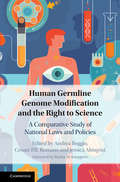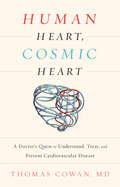- Table View
- List View
The Human Body (4th Edition)
by Debbie Lawrence Richard LawrenceUpdated 4th Edition! The human body is a complex wonder created by God. Learn about each system of the body and see how God designed our bodies to be truly amazing. Make a map of your tongue, a mold of your teeth, and a poster of your entire body. This is a fun and easy way to help your children realize they were created in God's image. 35 lessons.
The Human Body in Health and Illness (3rd Edition)
by Barbara HerlihyThrough a visually appealing design, The Human Body in Health and Illness, 3rd Edition describes complex concepts in a more simplified way and applies them to patient care. Aimed at students whose background in science is limited, the text assumes the reader has no previous knowledge in biology, chemistry, or physics and makes the information easy to read and understand. The text includes unique cartoons that use humor to make learning the content more enjoyable. The book also employs a body-systems approach to discuss the basic concepts of anatomy and physiology, building up from simple to complex topics. Original, full-color cartoons and illustrations complement the text and reinforce the content, making it accessible and user-friendly. The books logical, step-by-step presentation begins with a basic discussion of the human body and cellular structure and moves toward genetics and the greater complexity of the human organism. Do You Know boxes briefly cover many interesting issues appropriate to anatomy and physiology, including pathophysiology and historical background information. Disorders of the _____ System tables include specific disorders related to individual body systems. As You Age boxes describe how aging affects human anatomy and physiology. Sum It Up! content provides reinforcement and summary of key topics. New chapters on the autonomic nervous system, blood vessel anatomy, and blood vessel circulation take a deeper look into the areas of human anatomy and physiology. The companion Panorama of Anatomy and Physiology/Body Spectrum CD-ROM simplifies the process of learning medical terminology with 80 detailed anatomy illustrations to study, plus quizzes, movie clips, fun facts, and information on careers in the field of A & P.
The Human Body in Health and Illness (4th Edition)
by Barbara HerlihyThe Human Body in Health and Illness, 4th Edition makes it fun to learn anatomy & physiology. Clear, step-by-step explanations provide all the information you need to know, so concepts are easy to understand even if you have a limited background in the sciences. Written by well-known educator Barbara Herlihy, the book begins with a basic discussion of the human body and cellular structure and moves toward genetics and the greater complexity of the human organism. It breaks down complex concepts and processes into digestible chunks, and new features such as Re-Think and Go Figure! help you apply what you've learned to common problems in patient care. Unique! Original, colorful cartoons use humor to reinforce content, making it more accessible and user-friendly. Original, full-color illustrations complement the text and simplify both fundamental and complex concepts. Key terms are listed in chapter openers and defined in the glossary. A summary outline at the end of each chapter provides a useful study tool. Review Your Knowledge questions at the end of each chapter include multiple-choice and matching Unique! Do You Know boxes discuss pathophysiology issues or provide a historical connection to A&P. Unique! Disorders of the System tables summarize specific disorders related to individual body systems for easy reference. Sum It Up! reinforces and summarizes key topics. As You Age boxes describe how aging affects human anatomy and physiology. An updated Evolve companion website provides access to post-tests, animations, an audio glossary, and additional Do You Know vignettes. Re-Think sections ask you to review concepts and apply what you've learned. Unique! Ramp It Up! boxes connect material in the text to the clinical setting and your future career. Unique! Build-a-Word boxes help you learn and build upon new medical terminology. Unique! Go Figure! features ask you to reexamine diagrams, reinforcing the key points of each one. Unique! Bridges to Nursing Assessment Labs on the companion Evolve website bridge the gap between A&P theory and clinical application.
The Human Body in Health & Disease (2nd Edition)
by Gary A. Thibodeau Kevin T. PattonThis updated third edition includes outstanding coverage of basic anatomy and physiology, plus the mechanisms of disease and pathological conditions associated with each body system. Two unifying themes are integrated in this comprehensive text: the complementary nature of structure and function, and homeostasis. Homeostasis is used to show how "normal" structure and function are maintained, whereas failures of homeostasis are shown as basic mechanisms of disease. The reader is drawn into the subject by a clear, straightforward style, superior illustrations, and student-friendly features.
The Human Body in Health & Disease (3rd Edition)
by Gary A. Thibodeau Kevin T. PattonThis third edition includes outstanding coverage of basic anatomy and physiology, plus the mechanisms of disease and pathologic conditions associated with each body system. Two unifying themes are integrated in this comprehensive text: the complementary nature of structure and function, and homeostasis. Homeostasis is used to show how "normal" structure and function are maintained, whereas failures of homeostasis are shown as basic mechanisms of disease. The reader is drawn into the subject by a clear, straightforward style, superior illustrations, and student-friendly features.
The Human Body in Minutes (IN MINUTES)
by Tom JacksonA concise and illuminating tour of the human body - learn about how our bodies work and why they work the way they do, in minutes. From the basic unit of the cell, through the tissues and organs that make up the body's systems, to how these systems work together to form a complete human being, this book takes you on a journey through our anatomy and its intricate workings - and looks beyond to explore human evolution, inheritence and genetics, human behaviour, disease, death and medicine and how technology will transform the body of the future.With 200 cutting-edge anatomical images, cross-sections and close-ups that detail and explain the brain, eye, heart, skin, skeleton, lung, kidney, ear, blood, liver, stomach, muscles, veins, arteries, DNA, chromosomes and all of the key features of our bodies, this is the perfect, easy reference to the anatomy, physiology and science of the human body.
Human Body Systems: Book D (Glencoe Science)
by McGraw-Hill EducationHuman Body Systems, as a part of the Glencoe Science 15-Book Series, provides students with accurate and comprehensive coverage of the human body and its key organ systems. The strong content coverage integrates a wide range of hands-on experiences, critical-thinking opportunities, and real-world applications. The modular approach allows you to mix and match books to meet your curricula.
Human Brain and Senses Resources: Images, Data, and Readings
by Lawrence Hall of Science StaffTHE FOSS program for Middle School Science
Human by Design: From Evolution by Chance to Transformation by Choice
by Gregg BradenHuman by Design invites you on a journey beyond Darwin’s theory of evolution, beginning with the fact that we exist as we do, even more empowered, and more connected with ourselves and the world, than scientists have believed possible.In one of the great ironies of the modern world, the science that was expected to solve life’s mysteries has done just the opposite. New discoveries have led to more unanswered questions, created deeper mysteries, and brought us to the brink of forbidden territory when it comes to explaining our origin and existence. These discoveries reveal the following facts: • Fact 1. Our origin —Modern humans appeared suddenly on earth approximately 200,000 years ago, with the advanced brain, nervous system, and capabilities that set them apart from all other known forms of life already developed, rather than having developed slowly and gradually over a long periods of time. • Fact 2. Missing physical evidence —The relationships shown on the conventional tree of human evolution are speculative connections only. While they are believed to exist, a 150-year search has failed to produce the physical evidence that confirms the relationships shown on the evolutionary family tree. • Fact 3. New DNA evidence —The comparison of DNA between ancient Neanderthals, previously thought to be our ancestors, and early humans tells us that we did not descend from the Neanderthals. • Fact 4. A rare DNA fusion —Advanced genome analysis reveals that the DNA that sets us apart from other primates, including in our advanced brain and nervous system, is the result of an ancient and precise fusion of genes occurring in a way that suggests something beyond evolution made our humanness possible. • Fact 5. Our extraordinary abilities —We are born with the capacity to self-heal, to self-regulate longevity, to activate an enhanced immune response, and to experience deep intuition, sympathy, empathy, and, ultimately, compassion —and to do each of these on demand.In this book, New York Times best-selling author and 2017 Templeton Award nominee Gregg Braden crosses the traditional boundaries of science and spirituality to answer the timeless question at the core of our existence —Who are we? —and to reveal science-based techniques that awaken our uniquely human experiences of deep intuition, precognition, advanced states of self-healing, and much more! Beyond any reasonable doubt, Human by Design reveals that we’re not what we’ve been told, and much more than we’ve ever imagined.
Human Capacities and Moral Status
by Russell DisilvestroMany debates about the moral status of things--for example, debates about the natural rights of human fetuses or nonhuman animals--eventually migrate towards a discussion of the capacities of the things in question--for example, their capacities to feel pain, think, or love. Yet the move towards capacities is often controversial: if a human's capacities are the basis of its moral status, how could a human having lesser capacities than you and I have the same "serious" moral status as you and I? This book answers this question by arguing that if something is human, it has a set of typical human capacities; that if something has a set of typical human capacities, it has serious moral status; and thus all human beings have the same sort of serious moral status as you and I. Beginning from what our common intuitions tell us about situations involving "temporary incapacitation"--where a human organism has, then loses, then regains a certain capacity--this book argues for substantive conclusions regarding human fetuses and embryos, humans in a permanent vegetative state, humans suffering from brain diseases, and humans born with genetic disorders. Since these conclusions must have some impact on our ongoing moral and political debates about the proper treatment of such humans, this book will be useful to professionals and students in philosophy, bioethics, law, medicine, and public policy.
Human Design
by Chetan ParkynGoing beyond horoscopes, Human Design posits that everyone is born with an individuality as unique as a fingerprint. The detailed personality readings Human Design provides empower people to make decisions, choose professions, and create relationships with ease and success because they are no longer struggling against innate strengths and weaknesses. They are instead tapping into their personal power and destiny. Understanding these readings allows people to align their actions with their inherent, truest self. Chetan Parkyn, the foremost international practitioner of Human Design, now offers readers the tools to do their own readings (using a downloadable program), to map the life charts of friends and family, and even to explore the complete life charts of a variety of public figures. Simple, accurate, and wonderfully detailed, Human Design unlocks human potential by answering the age-old question, Who am I?
Human Design: The Revolutionary System That Shows You Who You Came Here to Be
by Jenna ZoeFind guidance, alignment, and purpose with this insightful, practical guide to understanding and interpreting your Human Design chart.World-leading expert Jenna Zoe reveals the power and potential of Human Design in simple steps and shows you how to utilize your results to create an incredible life. Drawing inspiration from many different schools of wisdom, including the chakras, I Ching, astrology, and the Tree of Life, Human Design is a system based on our time and date of birth, illustrated as a unique chart that reveals our opportunities, challenges, personality, strengths, relationships, and much more.Once you have your chart, you can tap into a detailed and unique toolkit to help you unlock your true purpose in this world. You'll discover how to:generate your own chart with an easy-to-follow process find out what your Energy Type is and how you can harness itstop striving to be someone you're not and feel comfortable in your own skinunderstand your intuition, personality, habits, relationships, and moreWhen your chart reveals how to be the real you – the most individual you can be – you'll find that you're able to confidently walk your unique path and live according to your soul's purpose.
Human Development: A Cultural Approach
by Jeffrey ArnettHelp students understand how culture impacts development – and why it matters Human Development: A Cultural Approach, Second Edition leads students to examine all stages of development through the engaging lens of culture. The first author to take a wholly cultural approach to human development, Jeffrey Arnett integrates cross-cultural examples throughout the narrative to reveal the impact of cultural factors both in the US and around the world. Arnett’s emphasis on culture fosters a thorough, balanced view of development that prepares students to face challenges in our diverse and globalized world – whether they travel the globe or remain in their hometowns.
Human Development: A Life-Span View
by John Cavanaugh Robert KailBalanced coverage of the entire life span is just one thing that distinguishes HUMAN DEVELOPMENT: A LIFE-SPAN VIEW, 6TH EDITION. With its comprehensive, succinct, and applied coverage, the text has proven its ability to capture students' interest while introducing them to the issues, forces, and outcomes that make us who we are. Robert V. Kail's expertise in childhood and adolescence, combined with John C. Cavanaugh's extensive research in gerontology, result in a book with a rich description of all life-span stages and important topics. A modified chronological approach traces development in sequential order from conception through late life, while also dedicating several chapters to key topical issues. This organization also allows the book to be relatively briefer than other texts a benefit given the enormous amount of information covered in the course.
Human Development
by James W. Van Der Zanden Corinne Haines Crandell Thomas L. CrandellHuman development
Human Development Across The Lifespan
by John S. Dacey John F. TraversThis chronologically-organized text is briefer than most of the Human Lifespan texts. Its numerous examples drawn from education, nursing, and psychology make the content relevant to students from a variety of majors and backgrounds, while a highly praised study guide integrated into the text promotes and reinforces conceptual understanding. The new edition includes increased material on cognitive development and expanded coverage of culture. .
Human Development Across the Lifespan
by John S. Dacey John F. Travers Lisa B. FioreAll of the lifespan without all of the bells and whistles. This chronologically-organized text is less expensive and briefer than most Lifespan texts. Its numerous examples drawn from education, nursing, and psychology make the content relevant to students from a variety of majors and backgrounds, while a highly praised study guide integrated into the text promotes and reinforces conceptual understanding.
The Human Enhancement Debate and Disability
by Miriam Eilers Katrin Gr�ber Christoph Rehmann-SutterImproving human characteristics goes beyond compensating for an impairment. This book explores the rich and complex relationship between enhancement and impairment, showing that the study of disability offers new ways of thinking about the social and ethical implications of improving the human condition.
Human Exceptionality: School, Community and Family, 11th Ed.
by Michael L. Hardman Clifford J. Drew M. Winston EganHUMAN EXCEPTIONALITY is an excellent resource for preparing teacher education candidates and practicing teachers, as well as a range of human services professionals. The book's unique human approach combines the most current research, personal stories about people with exceptionalities, and new and innovative features that create opportunities for readers to better understand and apply the information in each chapter.
Human Exceptionality: School, Community, And Family
by Michael L. Hardman Clifford J. Drew M. Winston EganExpanding on its widely respected and unique focus on the critical role of professionals in education, psychology, counseling, health care, and human services, HUMAN EXCEPTIONALITY: SCHOOL, COMMUNITY, AND FAMILY, 12th Edition, is an evidence-based testament to how cross-professional collaboration enhances the lives of exceptional individuals and their families. This text's unique lifespan approach combines powerful research, evidence-based practices, and inspiring stories, engendering passion and empathy and enhancing the lives of individuals with exceptionalities. Designed to help students experience individuals with disabilities and their families in a personal and intimate fashion, HUMAN EXCEPTIONALITY is an excellent resource for preparing both preservice and practicing teachers, as well as a range of other human services professionals in the fields of psychology, sociology, social work, and the health sciences.
Human Factors in Privacy Research
by Nina Gerber Alina Stöver Karola MarkyThis book covers topics needed to be considered in research around usable privacy. The book starts from a psychological perspective and introduces readers to basic behavioral theories and models that can explain end-user privacy behavior (including the “privacy paradox”) on a theoretical level. Subsequently, an introduction to different study methods (e.g., experiment, survey, interviews, co-creation) used in usable privacy research is given. Based on this, different methodological aspects, such as identifying appropriate questionnaires, and applying User-Centered Design, will be discussed. Finally, the book describes application areas for privacy research such as dark patterns and presents solutions for privacy protection, e.g., regarding consent-giving and PETs. The book aims to bring together the different research approaches to the topic of usable privacy, which often originate from computer science, psychology, and law, and provide a methodologically sound basis for researchers who want to delve deeper into this topic.This is an open access book.
Human Feelings: Explorations in Affect Development and Meaning
by Steven L. Ablon Daniel Brown Edward J. Khantzian John E. MackDwelling on the importance of emotions in our life, the author through Harvard Affect Study Group has brought together people with different kinds of training to share a passionate interest in the study of affect.
Human Gametes and Preimplantation Embryos
by David K. Gardner Denny Sakkas Dagan Wells Emre SeliIn recent years, the advancing science and increasing availability of assisted reproduction have given new hope to infertile couples. However, the use of IVF and ART has also led to marked increases in the number of multiple-infant live births. This poses a public health concern, as these neonates have a higher rate of pre-term delivery, compromising their survival chances and increasing their risk of lifelong disability. By optimizing the selection of gametes and embryos with high probabilities of implantation, it is possible to reduce the number of embryos transferred and, by extension, the number of high-risk multiple gestations, while maintaining or increasing pregnancy rates. Human Gametes and Preimplantation Embryos: Assessment and Diagnosis provides a broad yet concise overview of established and developing methodologies for assessment of gamete and embryo viability in assisted reproduction. This book elucidates the best practices for precisely selecting viable specimens based on morphology and cleavage rate and covers the spectrum of emerging adjunctive technologies for predicting reproductive potential. The authors present their extensive knowledge of "omics" approaches (genomics, transcriptomics, proteomics, and metabolomics), with unbiased delineation of the associated advantages and potential pitfalls. This valuable clinical resource is well suited to infertility specialists, Ob/Gyn physicians, IVF laboratory technicians, and researchers in the fields of embryology and reproductive medicine.
Human Germline Genome Modification and the Right to Science: A Comparative Study of National Laws and Policies
by Andrea Boggio Romano Cesare P. R. Jessica AlmqvistThe advent of the CRISPR/Cas9 class of genome editing tools is transforming not just science and medicine, but also law. When the genome of germline cells is modified, the modifications could be inherited, with far-reaching effects in time and scale. Legal systems are struggling with keeping up with the CRISPR revolution and both lawyers and scientists are often confused about existing regulations. This book contains an analysis of the national regulatory framework in eighteen selected countries. Written by national legal experts, it includes all major players in bioengineering, plus an analysis of the emerging international standards and a discussion of how international human rights standards should inform national and international regulatory frameworks. The authors propose a set of principles for the regulation of germline engineering, based on international human rights law, that can be the foundation for regulating heritable gene editing both at the level of countries as well as globally.
Human Heart, Cosmic Heart: A Doctor’s Quest to Understand, Treat, and Prevent Cardiovascular Disease
by Dr Thomas CowanThomas Cowan was a 20-year-old Duke grad--bright, skeptical, and already disillusioned with industrial capitalism--when he joined the Peace Corps in the mid-1970s for a two-year tour in Swaziland. There, he encountered the work of Rudolf Steiner and Weston A. Price--two men whose ideas would fascinate and challenge him for decades to come. Both drawn to the art of healing and repelled by the way medicine was--and continues to be--practiced in the United States, Cowan returned from Swaziland, went to medical school, and established a practice in New Hampshire and, later, San Francisco. For years, as he raised his three children, suffered the setback of divorce, and struggled with a heart condition, he remained intrigued by the work of Price and Steiner and, in particular, with Steiner's provocative claim that the heart is not a pump. Determined to practice medicine in a way that promoted healing rather than compounded ailments, Cowan dedicated himself to understanding whether Steiner's claim could possibly be true. And if Steiner was correct, what, then, is the heart? What is its true role in the human body? In this deeply personal, rigorous, and riveting account, Dr. Cowan offers up a daring claim: Not only was Steiner correct that the heart is not a pump, but our understanding of heart disease--with its origins in the blood vessels--is completely wrong. And this gross misunderstanding, with its attendant medications and risky surgeries, is the reason heart disease remains the most common cause of death worldwide. In Human Heart, Cosmic Heart, Dr. Thomas Cowan presents a new way of understanding the body's most central organ. He offers a new look at what it means to be human and how we can best care for ourselves--and one another.
